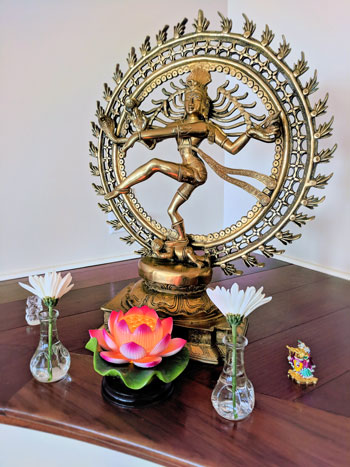by Michael Mamas | Monday, May 14, 2018 | Vedic Science |
 During Satya Yuga, Rakshasas live in a different Loka (plane of existence).
During Satya Yuga, Rakshasas live in a different Loka (plane of existence).
During Treta Yuga, Rakshasas live on a different island, like in the Ramayana.
During Dvapara Yuga, Rakshasas live in a different city or area on the same body of land, like in the Mahabharata.
During Kali Yuga, Rakshasas live in the hearts and minds of human beings.
© Michael Mamas. All rights reserved.
by Michael Mamas | Saturday, April 28, 2018 | Vedic Science |
 Rishi is the Knower, Chhandas the Known, and Devata the process of Knowing.
Rishi is the Knower, Chhandas the Known, and Devata the process of Knowing.
Rishi is the musician, Devata is the spirit or soul behind the music, and Chhandas is the rhythm and structure of the music itself.
The interesting insight here is that rhythm cannot exist independently of structure (the notes and their tone). It is the structure that gives the rhythm something to dance upon. The music, the Known (Chhandas) is the unification of the rhythm with the structure.
Yet, it is the Devata value (the process of Knowing and merging with the music) that gives it a soul, a meaning, a feeling. The musician finds that aliveness, that soul of the music, within, and infuses it into the Chaandas value through the process of Knowing (the Devata).
It is said that computer-generated music is somewhat sterile. Although such music is played with perfection, the process of Knowing is not lively. It is the personified value of the Devata component that breathes life into the music. If that is so, why does computerized Bach inspire so many so deeply?
The Rishi, Devata, and Chaandas value are intimately entwined. For example, we have Mozart, Beethoven, and Bach. A Bach fugue is very mathematical in its nature, lending itself well to computer-generated music. We could say that the Chhandas value, the music itself, has a strong mathematical component. Or we could say that it is the nature of the musician or composer who has an affinity for mathematical structure. Or we could say that it is the Devata value that has the mathematical orientation. In reality, all three components are fully enmeshed, entwined, and inseparable from one another. This is true not only of music, but with everything. It’s what makes the pillow a pillow, a cup a cup, and a tree a tree.
© Michael Mamas. All rights reserved.
by Michael Mamas | Thursday, June 1, 2017 | Vedic Science |

1. Consciousness becomes aware of itself and duality (relativity, manifest existence) is born.
2. In Christianity this is called the Father (Knower), the Son (the Known), and the Holy Spirit (process of Knowing). The Father is pure Consciousness, the Son is what Consciousness sees when it looks at itself and perceives it as other, and the Holy Spirit is a facet of the personified quality of God. As with all of us, the personality has many facets. As has been said, “God has many faces.”
3. In the Vedic tradition:
The Father = Rishi = Knower = pure Consciousness
The Son = Chandas = the Known = the object of perception
The Holy Spirit = Devata = process of Knowing = the relationship between Consciousness and the object it perceives, i.e., the process by which Consciousness becomes conscious of itself
| the Knower |
the Known |
the process of Knowing |
| Rishi |
Chandas |
Devata |
| Father |
Son |
Holy Spirit |
4. This is not only the manifestation of the process from Oneness to multiplicity, but also exists in the relationship between all things.
5. Right now, you are the Knower, the points listed here are the Known, and your relationship with these points is the process of Knowing.
6. There are many different ways you can look at the same thing: different processes of Knowing, Devata values.
7. Your relationship with the Devata value determines what you believe the Known (Chandas) to be.
8. Each of the three (Father, Son, Holy Spirit) affects (colors) the nature of the other two.
9. Reality is perspective.
10. There is no bottom line or, if you prefer, the bottom line is no-thing-ness, pure Is-ness, the field of pure Consciousness.
© Michael Mamas. All rights reserved.
by Michael Mamas | Tuesday, May 30, 2017 | Spiritual Evolution, Vedic Science |
- Vedanta is not really a philosophy. It is a state (level) of consciousness. In the state of Vedanta, one spontaneously sees through the veil of illusion. It is as if everything is lightly etched on the face of Oneness. It is not an attitude or philosophy. It is a physiological level of human evolution. If we’re not careful, studying Vedanta becomes an attempt to put Unboundedness in the boundaries of a box.
- Humans evolve through the elevation of their level of consciousness.
- Deep inside, everybody is one with the source of everything, the essence of all knowledge. This is why so many think they are enlightened when they first learn about Vedanta. The knowledge resonates with that deep inner knowing. Whether or not it is fully integrated with all levels of their being, is quite another matter. Enlightenment means integration.
- Trying to live a limited understanding of Vedanta as a behavior or philosophical overlay in daily life is epidemic, yet tragic. It is attempting to conform to a distorted notion. Enlightenment is not even about conformity. It’s about becoming integrated with the level of life that transcends conformity. Functioning harmoniously with the world of conformity is quite different from losing your Self to those conformities.
- People often think enlightenment looks a certain way, but it does not. Just as every snowflake is unique, every individual is unique.
- There are ever-increasing levels of understanding, but they all parallel. When someone understands Vedanta on a superficial level, it parallels deeper understandings. However, they think they get it. Echoes of Truth, perceived as Truth, hold Truth at bay. This is called the I-get-it Syndrome.
- There are an unlimited number of awakenings along the way. People have an awakening, think they are enlightened, think they ‘get it,’ and go out and teach. Tragic… well intended, but it leads people astray.
- People conform to superficial notions of enlightenment and decide they are enlightened. For example, it’s easy to hold hands and sway and get enchanted with the notion that we are all one. But ultimately, Oneness is something much deeper.
- Every level of understanding dictates a different world view. Once a particular level of understanding is identified with, people decide they ‘get it.’ This precludes them from going deeper. In the Vedic tradition, there is the notion of “Neti, Neti, Neti”: not that, not that, not that. Of course, people hear that notion and decide they ‘get it.” They decide their level of understanding is as deep as it goes.
- Non-attachment is not on the surface. It is deep inside. In the state of non-attachment (freedom from desire), we still can prefer salted caramel ice-cream over vanilla. The full range of emotions is still lived. Lord Rama fell to the ground and sobbed when his wife, Sita, was kidnapped. Yet he was living in the state of non-attachment.
- Some people think they can behave in a Vedantic manner. Behavior is superficial. Living Vedanta does not show on the surface. It is deeper than that.
- Doing the Vedanta cha-cha is a very common syndrome. People think they get Vedanta, enlightenment. But they are only clinging to echoes of Truth.
- It is not about intellectual understanding. It is a state of physiology.
- Every level of understanding is a self-sustaining, circular, impervious world of self-justification. People get stuck in a particular level of understanding. If you talk to them, they ‘get’ everything you say. If you say to them, “Enlightenment is deeper,” they say, “Right.”
- Attaining enlightenment is a highly elusive process, referred to as “traversing the razors edge” or “passing through the eye of the needle.”
- We live in Kali Yuga (the age of ignorance): Ignore-ance. Ignoring what lies deeper. Most ‘teachers’ read a few books, meditate a bit, decide they get it, and go out and teach.
- People sometimes say with pride something like: “I have been meditating for 30 years.” I respond by saying, “If you must measure, evolution is not measured in years, it is measured in lifetimes.”
- It is not comfortable to be in a room full of people identified with (indoctrinated into) a shared level of understanding/indoctrination. You will be judged if you do not conform.
- People call their ‘teacher’ someone who is more indoctrinated into (better at) their indoctrination than they are.

© Michael Mamas. All rights reserved.
by Michael Mamas | Wednesday, April 5, 2017 | Vedic Science |
 What is the difference between intellectually understanding Vedanta and embodying it?
What is the difference between intellectually understanding Vedanta and embodying it?
Do you embody it??
Really?
If not, how can you possibly understand it?
From the outside looking in, one cannot understand Vedanta.
In the depth of one’s being, everyone knows Vedanta.
To live it is another thing.
And that does not align with one’s preconceived notions of what that looks like (Not even you… no disrespect intended). Vedanta is not a philosophy or religion… It is a physiological state of being.
© Michael Mamas. All rights reserved.
 During Satya Yuga, Rakshasas live in a different Loka (plane of existence).
During Satya Yuga, Rakshasas live in a different Loka (plane of existence).
 Rishi is the Knower, Chhandas the Known, and Devata the process of Knowing.
Rishi is the Knower, Chhandas the Known, and Devata the process of Knowing.

 What is the difference between intellectually understanding Vedanta and embodying it?
What is the difference between intellectually understanding Vedanta and embodying it?